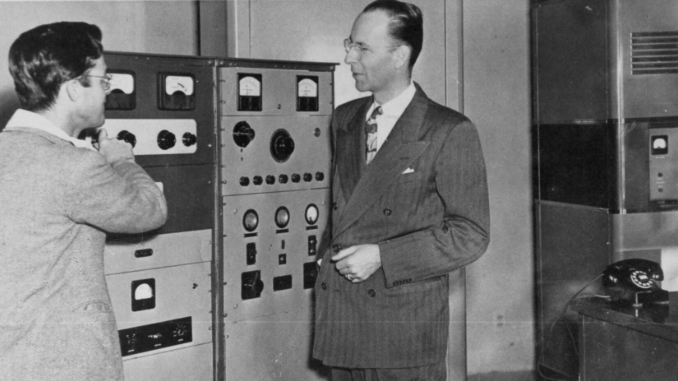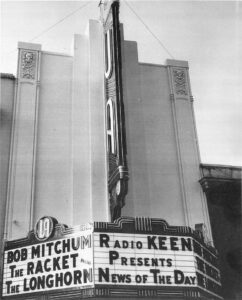
The Bay Area Radio Museum and Hall of Fame is pleased to offer this piece of Bay Area radio history, courtesy of the Snell family.

On November 15, 1983, Greg Snell sat down with his grandfather, George D. Snell Jr., to talk about the early days of KEEN, the station the elder Snell had helped put on the air in 1947 with his partners in United Broadcasting. We offer the audio recording of the interview here as well as a transcript below.
This is Greg Snell. I’m speaking with George Snell, President and Founder of United Broadcasting Company. Mr. Snell, you went on the air with KEEN in San Jose in 1947. Can you tell us how San Jose radio differed then from the way it is today?
Well, I think the biggest difference in radio today and what it was back in 1947 is that, at least in San Jose, more people are listening to local San Jose stations than they did in those days. In 1947, there were no radio stations here, actually. KQW had been here for many years, but it had moved to San Francisco and then suddenly within a year’s time, four AM radio stations were built in San Jose. The first one, I believe, was KSJO, which is now KLIV. The second was KLOK. The third was KEEN and the fourth was KXRX, which is now KHTT. And so all of a sudden, the San Jose listeners were able to tune in four local stations and they’d been used to listening to the San Francisco stations for so many years, all of which were up at the other end of the dial and most of them were network affiliates. And in 1947, TV had not come along yet. Radio stations still had the big stars, the network stars, and so it was a difficult thing to get a San Jose listener used to the idea of tuning in local stations. And so as a result, we really had kind of a difficult time selling advertising because we couldn’t prove that there were too many listeners. But as time went along and as TV came along, the big network stations in San Francisco lost their big programs. They began to play phonograph records just as we did. And local listeners found out that we could play records just as well as the other stations. And not only that, we were local. We had news on about San Jose, which people wanted to hear about. And we featured local personalities. In fact, Radio KEEN in the early days used to go out and pick up remotes, many local events, speeches, and openings, and put on special programs of live talent. And so it became a very different ball game after a few years. We’ve only mentioned AM radio.
What about FM radio?
AM radio was the only kind of radio there was back in 1947. There were some FM stations on the air, but nobody had any FM tuners, so nobody was listening. And there were no FM stations actually in San Jose. There was, I think, one in San Francisco. But FM didn’t mean a thing for many years. And as a matter of fact, it didn’t really become an important factor until the 1960’s, about the time that KBAY was put on the air. When we put KBAY on the air, I don’t think there were maybe a handful of receivers out there. But when stereo became a possibility on FM only, and the manufacturers of high-fi equipment began to exploit stereo, and when listeners found out the stereo made such a big difference in the way they enjoyed music, then FM listeners became numerous. And actually, KBAY became one of the most popular stations in the Bay Area almost overnight.
In 1947, did you attempt to compete with the network stations, or did you just start playing records right at the beginning?
No, that’s right. In the early days of AM, all the radio stations did play largely records, but there was a lot of live talent also, especially on KEEN. When we came to KEEN, when we built KEEN, we decided to put on as much local talent as we possibly could. And so we had dramatic programs, and we had live orchestra programs, and we had children’s programs. And those days, in fact, many AM stations put on a kind of vaudeville show. They had a different kind of programming throughout the day. There’d be a women’s program, and a children’s program, and classical music, and popular music, and so forth. It wasn’t until later, when there became quite a few AM stations on the air, they began to specialize in the programming. For instance, Radio KEEN began to play nothing but Country and Western music. And other stations started to play nothing but classical. And others only talk programs. And so it became a specialized kind of medium, which it is today.
Again, I’m speaking with George Snell, the president of United Broadcasting. Thank you, Mr. Snell.
RELATED EXHIBITS:
KEEN Named 2025 Legendary Station
